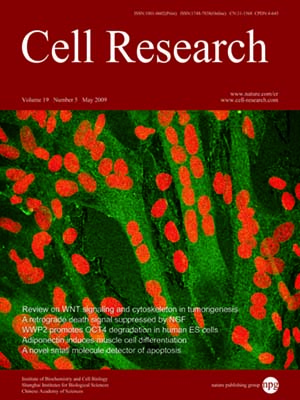
Volume 19, No 5, May 2009
ISSN: 1001-0602
EISSN: 1748-7838 2018
impact factor 17.848*
(Clarivate Analytics, 2019)
Volume 19 Issue 5, May 2009: 651-664
ORIGINAL ARTICLES
Temporal and spatial profiling of nuclei-associated proteins upon TNF-α/NF-κB signaling
Dan-jun Ma, Su-Jun Li, Lian-Shui Wang, Jie Dai, Shi-lin Zhao and Rong Zeng
Key Laboratory of Systems Biology, Institute of Biochemistry and Cell Biology, Shanghai Institutes for Biological Sciences, Chinese Academy of Sciences, Shanghai, 200031, China
Correspondence: Rong Zeng,(Rong Zeng,)
The tumor necrosis factor (TNF)-α/NF-κB-signaling pathway plays a pivotal role in various processes including apoptosis, cellular differentiation, host defense, inflammation, autoimmunity and organogenesis. The complexity of the TNF-α/NF-κB signaling is in part due to the dynamic protein behaviors of key players in this pathway. In this present work, a dynamic and global view of the signaling components in the nucleus at the early stages of TNF-α/NF-κB signaling was obtained in HEK293 cells, by a combination of subcellular fractionation and stable isotope labeling by amino acids in cell culture (SILAC). The dynamic profile patterns of 547 TNF-α-induced nuclei-associated proteins were quantified in our studies. The functional characters of all the profiles were further analyzed using that Kyoto Encyclopedia of Genes and Genomes (KEGG) pathway annotation. Additionally, many previously unknown effectors of TNF-α/NF-κB signaling were identified, quantified and clustered into differential activation profiles. Interestingly, levels of Fanconi anemia group D2 protein (FANCD2), one of the Fanconi anemia family proteins, was found to be increased in the nucleus by SILAC quantitation upon TNF-α stimulation, which was further verified by western blotting and immunofluorescence analysis. This indicates that FANCD2 might be involved in TNF-α/NF-κB signaling through its accumulation in the nucleus. In summary, the combination of subcellular proteomics with quantitative analysis not only allowed for a dissection of the nuclear TNF-α/NF-κB-signaling pathway, but also provided a systematic strategy for monitoring temporal and spatial changes in cell signaling.
Cell Research (2009) 19:651-664. doi: 10.1038/cr.2009.46; published 28 April 2009
FULL TEXT | PDF
Browse 1900


